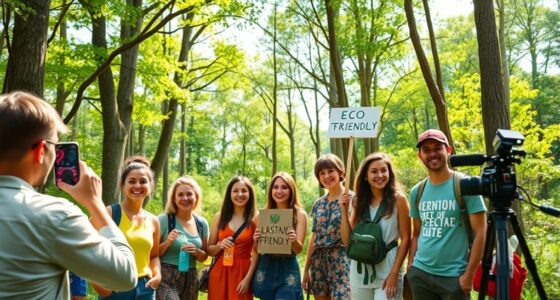Women are transforming how we protect and restore our planet’s biodiversity. They challenge old methods, harness new technologies, and push for policy changes that matter. Their efforts often go unnoticed, yet they’re making a lasting impact. Curious about how these trailblazers are shaping conservation’s future? The stories behind their work reveal a powerful movement you won’t want to overlook.
Pioneering Conservation Science and Research
Women have been at the forefront of developing innovative conservation science and research, driving new approaches to protect biodiversity. You see, they challenge traditional methods, applying fresh perspectives and interdisciplinary techniques.
These women lead groundbreaking studies on ecosystems, species preservation, and climate impacts, often bridging science with community engagement. Their research uncovers nuanced insights into habitat loss, invasive species, and environmental stressors.
By pushing boundaries, they develop targeted strategies that improve conservation outcomes. Their leadership in scientific institutions, universities, and research centers inspires future generations.
Through their dedication, they transform conservation from a purely scientific pursuit into a dynamic effort that combines technology, ecology, and social awareness. Their pioneering work reshapes how we understand and safeguard the natural world.
Advocates for Policy Change and Environmental Justice
Building on their scientific achievements, women are now championing policy reforms and environmental justice to ensure meaningful change. You see, they recognize that scientific data alone isn’t enough; policies must reflect that knowledge to protect biodiversity effectively. They are also utilizing crochet tools and techniques as symbols of empowerment, demonstrating how creative skills can support advocacy efforts. These women advocate for stronger environmental laws, equitable resource distribution, and the inclusion of marginalized communities in decision-making processes. They push for legislation that prioritizes sustainable development and holds corporations accountable. By amplifying voices often unheard, they fight systemic inequalities that threaten ecosystems and vulnerable populations alike. Their efforts aim to create lasting, equitable change that benefits both nature and society. Through activism, lobbying, and partnerships, these women are shaping a future where biodiversity preservation and social justice go hand in hand.
Groundbreaking Initiatives in Community Engagement
Have you ever wondered how community engagement can transform biodiversity conservation? When you involve local communities, you turn outsiders into active participants.
Women leaders are creating innovative programs that empower residents to protect their environment. For example, some initiatives train villagers as conservation ambassadors, giving them tools to monitor wildlife and manage natural resources.
Others foster eco-tourism or sustainable farming, providing economic incentives that align with conservation goals. These efforts build trust and deepen local commitment.
By integrating traditional knowledge with scientific approaches, women-led projects make conservation more effective and inclusive.
Your role as a supporter or participant can amplify these initiatives, ensuring community voices shape sustainable solutions.
Groundbreaking community engagement efforts are proving that when people are genuinely involved, biodiversity efforts thrive. Community involvement is essential for long-term conservation success.
Women Leading Endangered Species Recovery Programs
When it comes to saving endangered species, women are taking the lead in designing and implementing critical recovery programs. You’ll find women at the forefront of habitat restoration, breeding initiatives, and policy advocacy, ensuring these efforts are sustainable and inclusive. They coordinate teams, secure funding, and work closely with local communities to create effective strategies. Their expertise often bridges scientific research and on-the-ground action, making recovery plans more impactful. Many women in conservation have pioneered innovative approaches that address threats like habitat loss, poaching, and climate change. Their leadership fosters collaboration and resilience, empowering others to stay committed. Additionally, their focus on vetted safety and sustainability ensures that conservation efforts are both effective and ethically responsible.
Innovators Using Technology to Protect Biodiversity
Women conservationists are increasingly harnessing cutting-edge technology to enhance biodiversity protection efforts. They use tools like satellite imaging and drones to monitor ecosystems in real-time, making it easier to detect illegal activities like poaching and deforestation. These innovators develop and implement AI-powered algorithms that analyze vast amounts of data, identifying patterns and threats that might otherwise go unnoticed. Mobile apps and citizen science platforms empower local communities to report sightings and environmental changes, fostering grassroots involvement. By integrating technology into their strategies, women conservationists improve accuracy, efficiency, and responsiveness in conservation work. Their leadership in adopting these innovations accelerates efforts to protect endangered species and preserve habitats, proving that technology is a vital ally in the fight for biodiversity. Monitoring methods like visual inspection and data analysis play a crucial role in identifying issues early and responding effectively.
Mentors and Educators Shaping Future Conservation Leaders
Mentors and educators play a crucial role in shaping the next generation of conservation leaders by inspiring passion, sharing knowledge, and fostering critical thinking. You can influence emerging women in biodiversity by guiding their understanding of complex ecological issues and empowering their confidence.
Through hands-on experiences, you help students connect theory with real-world conservation efforts. Your mentorship sparks curiosity and resilience, encouraging them to pursue innovative solutions.
Educators also create inclusive environments where diverse voices are valued, helping women see themselves as future leaders. By providing resources, encouragement, and example, you cultivate a pipeline of capable, passionate conservationists.
Understanding self watering plant pots can serve as a practical analogy for nurturing growth and sustainability in conservation education.
Your dedication ensures that these future leaders carry forward the fight for biodiversity with knowledge, compassion, and unwavering commitment.
Conclusion
You’ve seen how these women are transforming biodiversity conservation through innovation, advocacy, and community work. Their leadership inspires change and proves that diverse approaches can make a real difference. By breaking barriers and pushing for justice, they’re safeguarding our planet’s future. Remember, you too can contribute—whether through education, activism, or supporting sustainable practices. Together, we can continue their legacy and help protect the incredible biodiversity that sustains us all.





